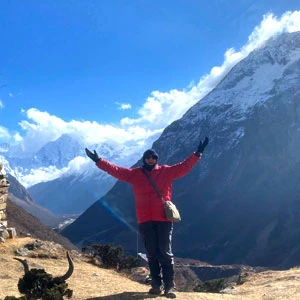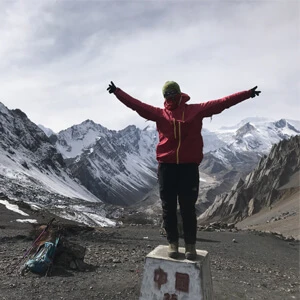Paragliding In Nepal
Nepal offers numerous opportunities for adventure over and above the usual attractions of the mountains, and foremost among them is the opportunity to paraglide from the foothills of the Himalayas, with 8000-meter giants such as Annapurna, Manaslu, and Dhaulagiri as a magnificent backdrop to your epic flight.
Our package involves a short drive from Pokhara to Sarangot (1,592 meters), one of the premier sights in Nepal for paragliding, where the pilot will give you a briefing before taking you to the slopes for the launch. No specific skill sets are required for the sport as it’s an extremely safe activity, and before you know it you’ll be soaring like a bird above the unforgettable landscape for half an hour or so before the pilot eases down for a gentle landing by the shores of beautiful Lake Phewa.
The cost of the flight is 120 US, with a video of the occasion to take home with you as a memento. For further information on this amazing experience please contact us.
What To Expect During Sarangkot Paragliding?
Paragliding in Sarangkot, Pokhara is an unforgettable experience, and here is the step-by-step guide on what to expect during it.
Pre-Flight Briefing
Before your adventure begins, the operators give you an introduction to the art of paragliding. Experienced pilots guide you through essential safety instructions, the mechanics of flight, and what to expect during take-off, in-flight, and landing. These briefings help to
calm your nerves. Then, they will gear you up with a harness, helmet, and windproof jacket while answering any last-minute questions.
Take-Off
The launch site at Sarangkot stands at an altitude of 1,592 meters. It offers awe-inspiring views of the Annapurna range, Pokhara Valley, and Phewa Lake. As you stand at the edge of the take-off point, you will take a short run forward. Soon, a gust of wind will catch your canopy and you will suddenly find yourself airborne.
In-Flight Experience
This is the magic moment. You will soar like a bird over the waters of Phewa Lake and terraced fields below. To the north, you will see the snow-capped peaks of Annapurna, Machhapuchhre, and Dhaulagiri. Additionally, you will also feel the cool breeze on your face as you share the skies with eagles and kites.
Landing
The landing zone is at Pame. The ground crew will guide you as you smoothly return to Earth, safe and sound, with a heart still soaring from the experience.
Post-Flight Experience (The Emotional Journey)
The first step back on the ground is a wave of accomplishment. The memories of gliding over one of the most picturesque landscapes in the world will replay in your mind.
Pilots often offer to share photos and videos from your flight, capturing your mid-air joy and awe-struck expressions. As you remove your gear, the realization of what you have just experienced will sink in: a blend of thrill, serenity, and the profound beauty of Nepal’s landscapes.
The Paragliding Destination: Sarangkot
Standing at an altitude of 1,592 meters, Sarangkot is a charming hilltop village just a short drive from Pokhara. It is one of the world's premier paragliding destinations. This tranquil spot boasts panoramic views of the snow-capped Annapurna mountain range, with peaks like Machhapuchhre (Fishtail) and Dhaulagiri. Its vantage point also overlooks the serene Phewa Lake.
What makes Sarangkot truly special is its perfect blend of natural beauty and ideal flying conditions. The hill’s location, weather patterns, and wind currents create the perfect setting for paragliding. On a clear day, the skies above Sarangkot come alive with colorful gliders floating effortlessly against the Himalayan backdrop.
Before launching into the skies, you can also enjoy the sunrise from this iconic spot. As the first ray of the sun hits, the mountains are painted in hues of gold and crimson.
Who Can Do Paragliding In Nepal?
The experience of paragliding in Nepal is accessible to most people, however, they must meet a few basic criteria.
Age And Weight Limit
Paragliding in Nepal is generally open to individuals aged 5 years and above, with minors requiring parental or guardian consent. Additionally, this activity accommodates a wide range of body weights, typically between 20 kg (44 lbs) and 100 kg (220 lbs). For those outside this range, it is essential to check with the paragliding company, as adjustments may be possible depending on conditions like wind speed and equipment limitations.
Health Considerations
While paragliding doesn’t demand physical strength, it’s important to be in reasonably good health. People with severe heart conditions, epilepsy, or other illnesses that could compromise safety during flight should avoid paragliding. Likewise, those prone to vertigo or motion sickness must consult their doctor beforehand. Lastly, pregnant women are generally discouraged from paragliding for safety reasons.
Best Time For Paragliding In Nepal
Nepal offers a paragliding experience like no other, with its dramatic landscapes, pristine lakes, and majestic Himalayan backdrop. To make the most of this adventure, timing is everything.
Autumn (September to November)
Autumn is the peak season for paragliding in Nepal. After the Monsoon rain clears the dust and haze from the air, you will see vivid blue skies and lush greenery. The wind conditions during this time are also stable, making it ideal for smooth flights. Furthermore, the unobstructed views of the Annapurna range, Machhapuchhre, and Dhaulagiri from Sarangkot are at their best during these months.
Spring (March to May)
Spring is another fantastic season for paragliding, as the weather remains dry and the skies are clear. This is also the time when Nepal’s hillsides are adorned with vibrant rhododendron blooms. Additionally, the slightly warmer temperatures and calm winds make Spring flights comfortable and enjoyable.
Winter (December to February)
For those who don’t mind cooler temperatures, Winter offers crystal-clear visibility and crowd-free take-off points. The mornings are often calm, with ideal wind conditions for paragliding. However, it’s best to layer up to stay warm as you glide through the chilly air.
Monsoon (June to August)
The Monsoon season is not suitable for paragliding due to heavy rains, frequent cloud cover, and unpredictable winds. The wet conditions make take-off and landing zones slippery, and visibility is often poor. Therefore, NTE does not recommend paragliding in this season.
Time Of The Day Also Matters
The best flights typically occur in the morning (9:30 AM to 12:30 PM) or early afternoon, when the winds are most favorable. During this period, the golden light of sunrise or the soft glow of late morning adds a magical touch to the experience.




